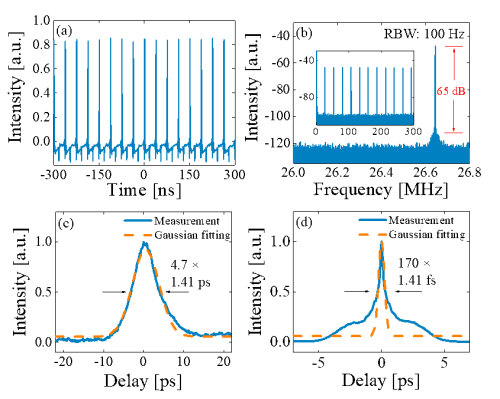A research team from Shanghai Institute of Optics and Fine Mechanics (SIOM) of the Chinese Academy of Sciences (CAS) reported a new approach to generate high pulse energy femtosecond pulses at 1319 nm by cascaded nonlinear optical gain modulation (NOGM) with a 1064 nm picosecond pump laser in phosphosilica fiber. The results were published in Optics Letters on March 22, 2023.
To meet the demands of applications such as multiphoton microscopy, femtosecond pulses at 1.3 μm are of great interests. NOGM is a new method to obtain highly coherent femtosecond Raman pulses, and the researchers have generated femtosecond pulses at 1120 nm and 1178 nm in previous work. However, four-stage Raman conversion process is needed to generate 1319 nm pulses from a 1064 nm pump laser. The phosphosilica fiber has a Raman gain peak at 39.6 THz, which is three times longer than that of the conventional silica fiber.
The researchers obtain 1319 nm pulses in phosphosilica fiber with 33.7 nJ pulse energy and 170 fs pulse duration with a conversion efficiency of 34%. The cascaded NOGM offers a new technique to obtain high performance Raman pulses at 1.3 μm for applications such as multiphoton microscopy.
In the demonstration, both 1121 nm and 1319 nm single frequency laser are injected into a Raman fiber amplifier, which is pumped by a 1064 nm picosecond pulse laser. The NOGM process was accomplished in a piece of 4.5-meter-long phosphosilica fiber. The two-stage NOGM setup generates 1319 nm pulses with a pulse energy of 33.7 nJ and a pulse duration of 170 fs (after compression) under an optical conversion efficiency of 34%.
Numerical simulations based on generalized nonlinear Schrodinger equation (GNLSE) are carried out to optimize the characteristics of the output Raman pulses. By changing the pump pulse energy to 1 μJ and the pump pulse duration to 50 ps, 1319 nm Raman pulses with a pulse energy of 668 nJ and 391 fs are obtained with a conversion efficiency of 67%.
The novel method combines the advantages of simple and stable compact, high pulse coherence and high optical conversion efficiency.

Fig. 1. The configuration of the cascaded NOGM setup. YDFA: Yb3+-doped fiber amplifier, WDM: wavelength division multiplexer; PDF: phosphorous-doped fiber. (Image by SIOM)

Fig. 2. The characteristics of generated Raman output pulses. (a) pulse train; (b) radio frequency (RF) spectrum; (c) autocorrelation trace before and (d) after compression. (Image by SIOM)
Article website:
https://doi.org/10.1364/OL.484175
Contact:
WU Xiufeng
General Administrative Office
Shanghai Institute of Optics and Fine Mechanics, CAS
Email: xfwu@siom.ac.cn
Web: http://english.siom.cas.cn/